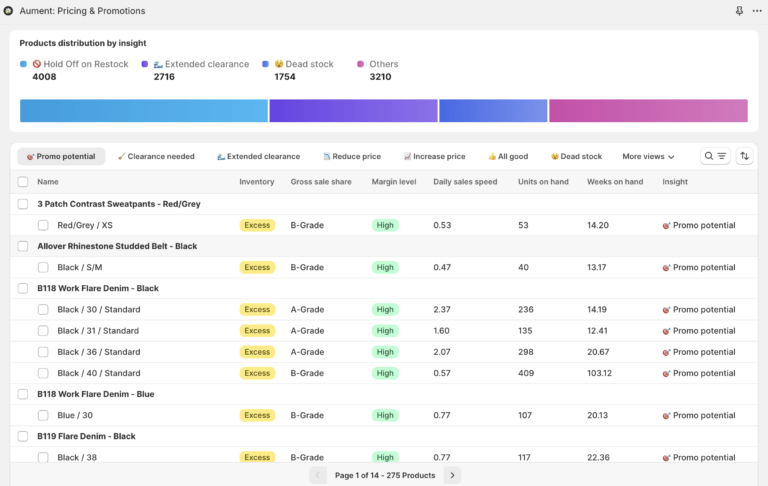How to Implement Dynamic Pricing Successfully in Ecommerce: Do’s and Don’ts
Dynamic pricing has come under scrutiny, particularly with high-profile cases like Ticketmaster’s controversial use of the strategy during Oasis’s much-anticipated comeback concert. After several years of the band being apart, their reunion sparked huge demand for tickets. Ticketmaster’s dynamic pricing caused ticket prices to surge, leaving fans frustrated and disillusioned. This serves as a reminder that knowing how to implement dynamic pricing properly is crucial to maximizing revenue without alienating customers.
Dynamic pricing, sometimes confused with real-time pricing (though not exactly the same), allows ecommerce stores to adjust prices based on changing conditions, like demand, inventory, or competitor pricing. This approach helps businesses optimize revenue and remain competitive.
What is Dynamic Pricing?
Dynamic pricing is a strategy where prices fluctuate based on various external factors, using algorithms that consider customer behavior, competitor prices, and stock levels. While it automates price changes, dynamic pricing is not limited to real-time updates; instead, it can adjust over time depending on business rules and goals.
By setting clear rules for price adjustments, businesses can balance profitability and customer satisfaction, ensuring that price fluctuations are aligned with their brand strategy.
The Benefits of Dynamic Pricing
Dynamic pricing offers several key advantages for ecommerce stores:
- Maximizing Revenue: Prices rise during high-demand periods, capturing more value from customers willing to pay a premium.
- Improving Inventory Turnover: Prices can be lowered when demand is low, helping to clear out excess stock.
- Automation: Avoiding manual adjustments reduces human error and saves time.
- Competitiveness: Reacting to competitor pricing in real time helps stores stay relevant in the market.
- Margin Optimization: Avoids unnecessary discounts, ensuring prices are optimized for profitability.
Beyond profit maximization, dynamic pricing reduces the burden of constant price adjustments and guessing.
How to Implement Dynamic Pricing in Ecommerce
Successfully implementing dynamic pricing involves a strategic approach that aligns with your brand goals. Here’s a step-by-step guide:
- Set Clear Objectives: Define whether you aim to increase revenue, clear inventory, or attract customers, as this will guide your pricing strategy.
- Leverage Data: Collect insights from customer behavior, competitors, and inventory to inform pricing decisions. The more accurate your data, the better your pricing model will be.
- Maintain Price Consistency: Be mindful of how frequent price changes affect bundled or packed items and ensure consistency with your brand’s overall strategy.
- Align with Marketing and Paid Media: Dynamic pricing should work alongside your acquisition efforts, such as paid media campaigns and broader communications.
- Set Rules for Price Changes: Establish rules that determine when and how prices adjust based on stock, demand, or competitor activity. This prevents prices from fluctuating too drastically, which could confuse customers.
- Start Small, Test, and Adjust: Begin with a small selection of products and evaluate customer response. Conduct regular testing to fine-tune your strategy and make adjustments based on the results.
- Monitor Continuously: Dynamic pricing is an ongoing process. Track how price changes impact sales and adjust the strategy to optimize performance while maintaining customer trust.
Potential Pitfalls to Avoid
Dynamic pricing, while powerful, can pose risks if not managed carefully. Rapid or unpredictable price fluctuations may confuse or frustrate customers, leading to dissatisfaction and potential churn. Consistency is key, especially for bundles or packs, to ensure that customers have a cohesive experience. Additionally, engaging in price wars with competitors by constantly adjusting prices can erode your profit margins. It’s better to focus on delivering value rather than competing solely on price.
Frequent price changes that are misaligned with your brand strategy can also damage your reputation. For premium ecommerce stores, erratic pricing may conflict with a brand identity built on quality or reliability. Dynamic pricing should always complement your acquisition efforts, paid media, and communication strategy to maintain a clear and consistent message.
Conclusion
While dynamic pricing can significantly increase profitability and improve efficiency, it must be used carefully, as seen in the case of Oasis’s comeback concert. For Shopify stores, dynamic pricing offers the potential to optimize revenue while staying competitive in the fast-paced ecommerce world. However, successful implementation hinges on thoughtful strategy, data-driven decisions, and constant monitoring.
By understanding how to implement dynamic pricing, you can harness its power to grow your store without compromising customer loyalty or brand integrity.
Ready to automate your pricing and stop guessing? Schedule a demo with Aument to discover how we can help you scale your store with data-driven pricing strategies.






